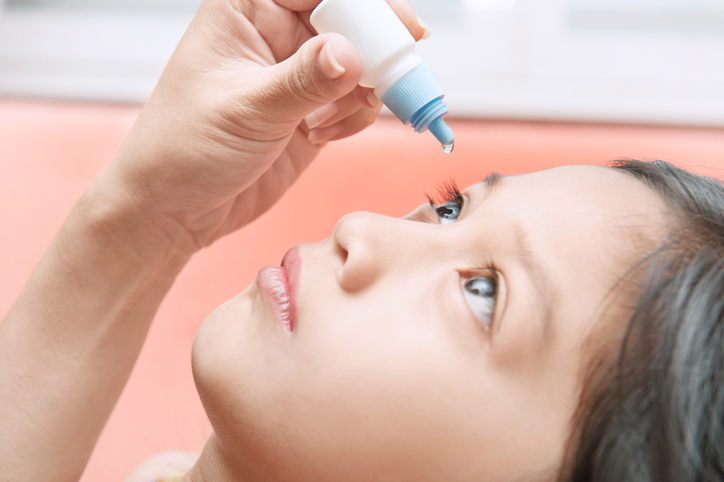 |
| The study found that Asian children experience faster myopic progression, and hence greater responsiveness to 0.01% atropine, than other races. Photo: Getty Images. Click image to enlarge. |
While myopia management is gaining in prominence worldwide, it is nevertheless still new enough to leave many important questions unanswered at present. The top interventions—multifocal contact lenses, orthokeratology and atropine eye drops—have each demonstrated efficacy, but protocols to guide clinical application are often lacking.
Researchers have sought clarity on how to balance efficacy with side effect profile when selecting the appropriate concentration of atropine at least since 2006, when the ATOM1 study was published. While the pharmacological intervention has been studied primarily in Asia, generally with favorable results, a new American-based clinical trial published in JAMA Ophthalmology failed to replicate the slowing of myopia progression seen in studies of East Asian kids.
An OD-MD group of researchers from the Pediatric Eye Disease Investigator Group tested atropine 0.01% against placebo for slowing myopia in US children. Kids aged five to 12 years old were included across 12 different community- and institution-based practices. Refractive error ranged from low to moderate bilateral myopia (-1.00D to -6.00D). The primary outcome of the study was change in spherical equivalent refractive error (SER), as a mean of both eyes, from baseline to 24 months receiving treatment. Other outcomes were spherical equivalent change from baseline out to 30 months (the last six months not receiving treatment) and axial length change at both time points.
A total of 187 children were included in the study (mean age 10 years), with 67% receiving atropine and 33% receiving the placebo. Follow-up at 24 months was completed by 95% of the atropine group and 94% of the placebo group, which stayed consistent at 30 months as well, with the atropine group displaying a 94% follow-up rate and placebo group a 92% rate.
The adjusted mean change in SER at the 24-month primary outcome visit was -0.82D in the atropine group and -0.80 in the placebo group. At 30 months—that is, six months after cessation of treatment—adjusted difference in mean SER change from baseline was -0.04D. Adjusted mean changes in axial length from baseline to 24 months was 0.44mm for the atropine group and 0.45 for placebo recipients, and mean axial elongation from baseline to 30 months was +0.009mm.
Based on the similar numbers between groups, the study authors concluded in their paper that “these results do not support the nightly use of low-dose atropine, 0.01%, eye drops to slow myopia progression in US children.”1
They were quick to point out, however, that these results are much different from five clinical trials conducted in East and South Asian populations with similar age and refractive error eligibility criteria. In 2012, the ATOM2 trial saw differences in SER myopia progression but not axial elongation over two years; however, there was no placebo control group, which reduced certainty of evidence. More recently, the 2019 LAMP study saw reduction in myopia progression and axial length elongation over one year, but higher atropine concentrations were found more effective than lower ones. Another study saw myopia progression reduction after two years and another after one year, while yet another saw reduction in mean SER progression after one year; all studies used 0.01% atropine.
This contrasts with one two-year clinical trial conducted in Western Australia, which did not find significant myopia progression difference when compared with placebo. That study also had similar age and refractive error eligibility criteria to the present research appearing in JAMA Ophthalmology.
Elucidated by the authors and expanded upon by an invited commentary also published by JAMA Ophthalmology, one potential reason for this observed difference is that low-concentration atropine may work better for Asian children than other racial or ethnic populations, particularly those of Caucasian origin. Since atropine binds to melanin, the commentary authors noted that the darker irises typical of Asian subjects may have resultant slower release and longer active drug time, which may yield higher effectivity in Asian children. This group also typically shows faster progression of myopia, which means the treatment effect is likely to also be greater.
Another possibility pointed out by the commentary is that studies longer than one year frequently don’t report additional accrual of treatment effect, so longer trials are less likely to report significant effect, like the present study, when compared with the mostly one-year trials of Asian children.
Finally, the commentators explain age may play a role, since myopia progression slows with age, and studies conducted on Caucasian children have included subjects up to 16 years old, while the Asian studies maxed out at age 12 in three out of four conducted.
In light of these possibilities, the study authors believe that “future studies of pharmacologic myopia control in US children should consider increased atropine concentrations, new pharmaceuticals, objective measures of treatment adherence, alternative eye drop delivery systems and schedules as well as evaluating the impact of environmental and genetic factors and optical interventions on myopia control treatment.”1
The authors of the commentary feel similarly but point out that “stronger concentrations of atropine should be considered for first-line treatment of myopia progression, especially when considering eye growth outcomes in white children.”2
1. Repka MX, Weise KK, Chandler DL, et al. Low-dose 0.01 atropine eye drops vs. placebo for myopic control: a randomized clinical trial. JAMA Ophthalmol. July 13, 2023. [Epub ahead of print]. 2. Walline JJ, Berntsen DA. Atropine, 0.01%, or myopia control. JAMA Ophthalmol. July 13, 2023. [Epub ahead of print]. |

